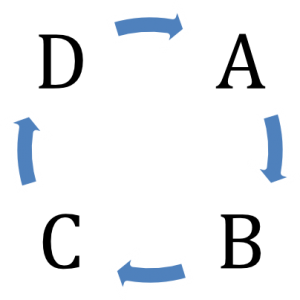JAPANESE ROTATIONAL BREEDING PLAN
(Known as Modoshi Kohai)
For breeders who are influenced by this traditional Japanese rotational breeding plan, promoted by well-known Japanese Wagyu breeder Shogo Takeda, an updated version follows – including our battery of Lone Mountain Sires. The system consists of sires being divided into groups (either Marbling or Frame). There are just two rules:
First – Cows sired by “Frame” Sires should be bred to “Marbling” and
Second – Cows sired by “Marbling” Sires should be bred to “Frame” Sires
A sire is determined to be of one of these two groups by a straightforward and effective assessment tool: the Japanese 16-16 Analysis. First, the combination of key regional Wagyu strains is identified over four generations in an individual’s pedigree. Second, the combinations are analyzed for those strains’ likely outcomes. With that analysis in mind, successful breeding choices are made clear.
Kenichi Ono puts forth in his book 100 Elite Wagyu Sires in Japan (Vol I-III) a definition of “successful breeding”, which is echoed by Takao Suzuki and Mike Buchanan at the Australian Wagyu Forum:
- Understand the characteristics of each strain
- Plan combinations to cover weak points of individual strains
- Don’t over-emphasize one strain.
- In this way, one can use the 16-16 analysis to get a sense of the outcome of breedingone animal to another.
As a point of reference, the following major strains and sub-strains of Japanese Black Wagyu commonly exhibit the following traits:
- Okayama (Shimomae): Large Frame
Sub-strains: Shimomae, Kiyokuni, Fujiyoshi, Itozakura - Shimane: Outstanding Structure, Strong Length, Depth, and Good Milk
Sub-strain: Itozakura - Tottori: Large Frame, Superior Meat (Marbling) Quality, Good Milking
Sub-strains: Eiko, Kedaka - Hyogo (Tajima): Superior Marbling, Most Popular
Sub-strains: Yasumi Doi, Kikumi Doi (aka Kikuteru Doi), Oku Doi, Shigakananemi (aka Kumanami), Shiroiti, Kanemon

THE ROTATIONAL BREEDING SYSTEM GROUPS ARE LISTED BELOW:
[FRAME]
GROUP A FRAME SIRES ARE:
- TF ITOHANA 2
- ITOSHIGEFUJI TF147
- ITOMORITAKA ETJ 002
GROUP C FRAME SIRES ARE:
- WKS KITAGUNI JR
- WKS TAKAZAKURA
- TF ITOMICHI 1-2
- ITOZURUDOI TF151
- HIRASHIGETAYASU ETJ 001
LMCC Sires:
- LMR KENICHI 807T
- LMR TOSHIRO 1-3 723T
- BAR R 12P TAKAZAKURA
- LMR SENSEI 817T
- LMR MICHIRO 0193X
- LMR YOSUKE 5165C
- LMR KATSURU 4278B
- LMR HAYAO 5549C
- LMR MASAHIKO 1250Y
- LMR KITAGUNI 1441Y
- LMR AKAHIGE 8119U
- LMR ICHIBAN 810T
- LMR HIRASHIGETAYASU 462Z
- LMR DAISUKE 2470Z
- LMR HAYAO 5549C
- LMR KAZUKI 770T
- LMR TAISUKE 401B
[MARBLING]
GROUP B MARBLING SIRES ARE:
- WKS SANJIROU
- WKS YASUFUKU JR
- JVP FUKUTSURU 068
- JVP KIKUYASU 400
- WKS MICHIFUKU
- TERUTANI TF40
- KITATERUYASUDOI ETJ 003
- ITOSHIGENAMI TF148
- KIKUTERUSHIGE TF150
- KIKUTSURUDOI TF146
LMCC Sires:
- BAR R SANJIROU 4P
- LMR AOICHI 2468Z
- WKS-LMR MICHIFUKU 3500A
- LMR HIROYUKI 3492A
GROUP D MARBLING SIRES ARE:
- WKS HARUKI II
- WKS SHIGESHIGETANI
LMCC Sires:
- LMR YOJIMBO 634S
- LMR HIRO 0195X
- LMR HIROSHI 766T
- LMR SHICHIRO 2403Z
- LMR YASUMASA 2428Z (CL16+)
- LMR MITSURU 2450Z
- LMR HARUKICHI 5106C
- WKS-LMR MICHITSUGU 3489A
- LMR YASUFUKU 2416Z
- LMR HARUKIRO 5340C
- LMR KUROSAWA 5301C
- LMR SHUNICHI 5339C
- LMR YOSHIHIRO 4335B
- LMR KAZUHIRO 351
With one exception as noted, All LMCC Sires are Genetic Defect FREE – determined by parentage or by test. LMCC semen is distributed by ORIgen, Huntley, MT – http://www.origenbeef.org or call; 1-866-867-4436 and ask to speak with Lone Mountain representative.
